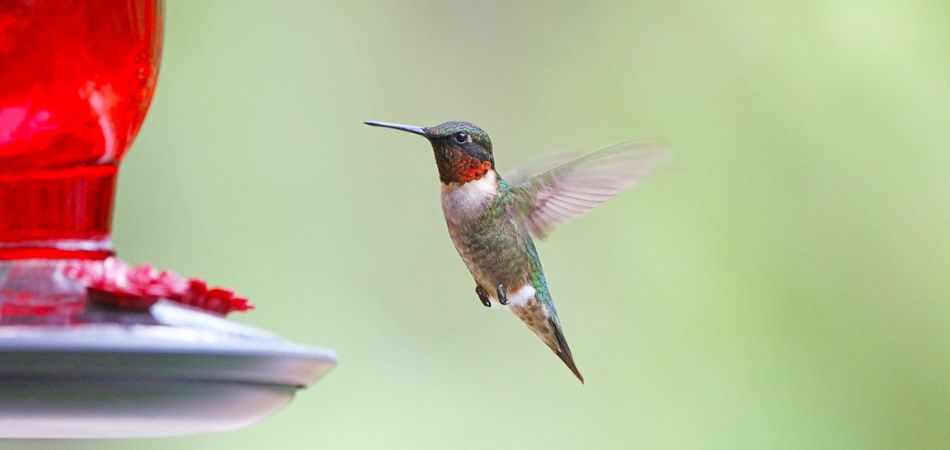Hummingbirds are enchanting creatures that bring joy and wonder to any garden. Known for their iridescent plumage and agile flight, attracting these tiny birds can be a rewarding experience for any bird enthusiast. Here’s everything you need to know about these delightful visitors.
Attracting Hummingbirds
To attract hummingbirds to your garden, consider the following tips:
Plant Nectar-Rich Flowers:
Hummingbirds are attracted to brightly colored, tubular flowers such as salvia, fuchsia, bee balm, and trumpet vine.
Provide Hummingbird Feeders with Nectar:
Here’s how to make your own Hummingbird Nectar.
- Mix the Sugar and Water: In a saucepan, combine 1 part white granulated sugar with 4 parts water. For example, use 1 cup of sugar with 4 cups of water for a larger batch.
- Heat and Stir: Heat the mixture over medium heat, stirring constantly until the sugar completely dissolves. This will create a clear sugar water solution.
- Cool the Nectar: Allow the nectar to cool completely before using it in your hummingbird feeder. Do not use hot or boiling nectar as it can harm hummingbirds.
- Fill the Feeder: Carefully pour the cooled nectar into your hummingbird feeder. Avoid overfilling to prevent spillage.
- Store Unused Nectar: If you have leftover nectar, you can store it in the refrigerator for up to one week. Discard any unused nectar that appears cloudy or has changed color.
Tips for DIY Nectar:
Use Only Sugar and Water: Do not add food coloring, honey, or artificial sweeteners to the nectar. Hummingbirds only need a simple sugar solution.
Cleanliness is Key: Clean your hummingbird feeder regularly (every 2-3 days in hot weather) to prevent mold and bacteria growth. Rinse the feeder with hot water and a bottle brush, and refill with fresh nectar.
Change Frequently: In warm weather, nectar can spoil quickly. Replace the nectar every 2-3 days, even if it hasn’t been completely consumed, to maintain freshness and keep hummingbirds healthy.
Create a Water Feature in Your Yard:
Hummingbirds love water. Install a small fountain or misting system to provide them with a source of water for bathing and drinking.
Visit Applewood Nursery & Landscape Supply To See All Of Our Hummingbird-Friendly Products!
What Hummingbirds Eat
Hummingbirds primarily feed on nectar from flowers using their long, specialized bills and tongues. In addition to nectar, they also consume small insects and spiders for protein, especially during nesting season.
Best Time to See Hummingbirds
The best time to see hummingbirds is during their active season, which varies by region but generally spans from late spring to early fall. In North America, peak hummingbird activity is often observed from April through September.
Facts About Hummingbirds
Size and Weight: Hummingbirds are among the smallest birds in the world. The smallest species, such as the Bee Hummingbird, measure only about 2.25 inches (5.7 cm) in length and weigh less than a penny.
Flight Abilities: Hummingbirds are incredible flyers, capable of hovering in mid-air by rapidly flapping their wings in a figure-eight pattern. They can also fly backward, sideways, and upside down with remarkable agility.
Heart Rate: Hummingbirds have incredibly fast heart rates, ranging from 1200 to over 1500 beats per minute (bpm) during flight. At rest, their heart rates slow down to conserve energy.
Feeding Habits: Hummingbirds primarily feed on nectar from flowers using their long, specialized bills and extendable, tubular tongues. They also consume small insects and spiders for protein.
Metabolism: Hummingbirds have the highest metabolism of any warm-blooded animal. They need to consume large amounts of food (mainly nectar) to fuel their high energy needs.
Migration: Many species of hummingbirds are migratory, traveling impressive distances between their breeding and wintering grounds. Some Ruby-throated Hummingbirds, for example, migrate non-stop across the Gulf of Mexico, covering about 500 miles (800 km) in a single flight.
Coloration: The vibrant colors of hummingbirds are not due to pigment but are the result of iridescence caused by the refraction and scattering of light on the surface of their feathers.
Territorial Behavior: Male hummingbirds are fiercely territorial and will defend feeding territories vigorously, often engaging in aerial battles to protect their food sources.
Nesting: Hummingbirds build intricate cup-shaped nests using materials like plant fibers, spider silk, and bits of lichen. The nests are camouflaged with lichen and positioned on tree branches or other structures.
Lifespan: The lifespan of hummingbirds varies by species, but most live 3-5 years on average. However, some may live longer in optimal conditions.
Bring Home the Magic
At Applewood Nursery & Landscape Supply, we offer a range of plants, birdseed, and feeders designed to attract and nourish hummingbirds. Enhance your garden’s appeal and create a haven for these delightful birds with our quality products. Invite the beauty of hummingbirds into your garden today!
Visit Applewood Nursery & Landscape Supply To See All Of Our Hummingbird-Friendly Products!

